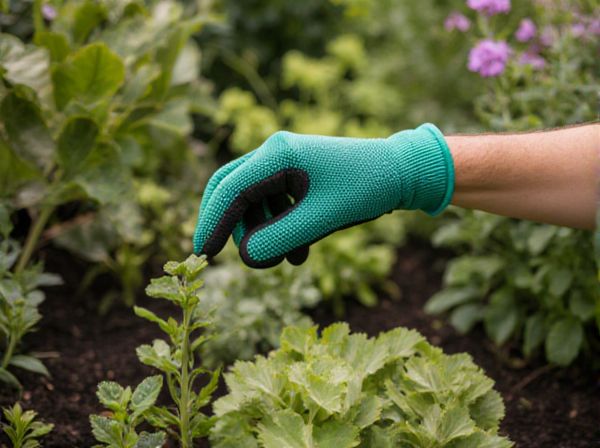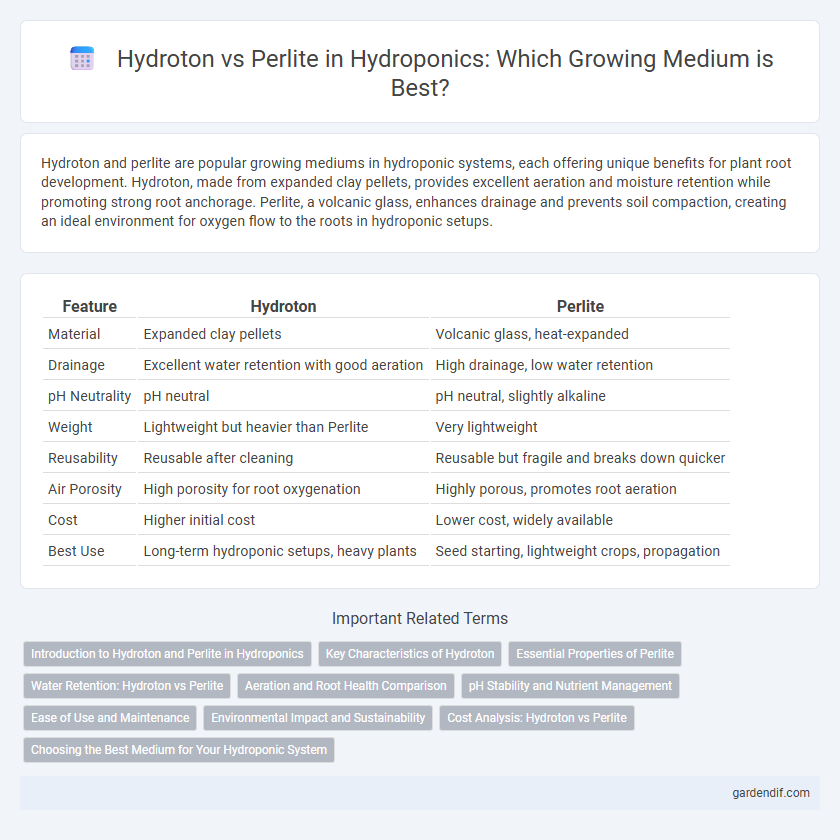
Hydroton vs Perlite Illustration
Hydroton and perlite are popular growing mediums in hydroponic systems, each offering unique benefits for plant root development. Hydroton, made from expanded clay pellets, provides excellent aeration and moisture retention while promoting strong root anchorage. Perlite, a volcanic glass, enhances drainage and prevents soil compaction, creating an ideal environment for oxygen flow to the roots in hydroponic setups.
Table of Comparison
| Feature | Hydroton | Perlite |
|---|---|---|
| Material | Expanded clay pellets | Volcanic glass, heat-expanded |
| Drainage | Excellent water retention with good aeration | High drainage, low water retention |
| pH Neutrality | pH neutral | pH neutral, slightly alkaline |
| Weight | Lightweight but heavier than Perlite | Very lightweight |
| Reusability | Reusable after cleaning | Reusable but fragile and breaks down quicker |
| Air Porosity | High porosity for root oxygenation | Highly porous, promotes root aeration |
| Cost | Higher initial cost | Lower cost, widely available |
| Best Use | Long-term hydroponic setups, heavy plants | Seed starting, lightweight crops, propagation |
Introduction to Hydroton and Perlite in Hydroponics
Hydroton, also known as expanded clay pellets, is a popular hydroponic growing medium prized for its excellent drainage, aeration, and reusability in systems like ebb and flow or drip irrigation. Perlite, a volcanic glass that expands when heated, provides lightweight, sterile particles that improve aeration and water retention in hydroponic substrates such as nutrient film technique and deep water culture. Both Hydroton and Perlite offer unique benefits for root oxygenation and moisture balance, making them essential choices depending on the specific hydroponic application.
Key Characteristics of Hydroton
Hydroton, also known as expanded clay pellets, features a porous structure that provides excellent aeration and drainage, making it ideal for hydroponic systems. Its lightweight nature and pH neutrality ensure stable root environments, promoting healthy plant growth and reducing the risk of root rot. Unlike perlite, Hydroton is reusable and offers superior mechanical stability, which supports robust root anchorage throughout the growing cycle.
Essential Properties of Perlite
Perlite is a lightweight, volcanic glass that expands when heated, providing excellent aeration and drainage for hydroponic systems. Its porous structure retains moisture while preventing waterlogging, promoting healthy root oxygenation and reducing the risk of root rot. Unlike Hydroton, perlite is inert, sterile, and pH neutral, making it an ideal growing medium for consistent nutrient delivery and root health.
Water Retention: Hydroton vs Perlite
Hydroton provides moderate water retention by allowing excess moisture to drain while maintaining adequate oxygen levels for roots, making it ideal for preventing overwatering. Perlite offers higher water retention due to its porous structure but drains quickly to avoid waterlogging, supporting aeration in hydroponic systems. Both substrates optimize root hydration differently, with Hydroton balancing moisture and aeration and Perlite enhancing water retention and drainage efficiency.
Aeration and Root Health Comparison
Hydroton provides superior aeration due to its porous clay structure, promoting robust root oxygenation and minimizing root rot risks compared to perlite. Perlite offers good drainage but lacks the consistent air pockets that Hydroton's round pellets create, which can limit oxygen flow around roots. Enhanced aeration in Hydroton environments leads to healthier roots and improved nutrient uptake, vital for hydroponic plant growth.
pH Stability and Nutrient Management
Hydroton provides excellent pH stability due to its inert clay composition, which does not alter the nutrient solution's pH levels, ensuring consistent nutrient availability for plants. Perlite, while lightweight and aerative, can sometimes cause pH fluctuations because of its slight alkalinity and potential to leach minerals. Effective nutrient management is easier with Hydroton as it maintains a stable root environment, whereas Perlite requires more frequent monitoring and adjustments to prevent nutrient imbalances.
Ease of Use and Maintenance
Hydroton offers superior ease of use with its lightweight, reusable clay pellets that provide excellent aeration and drainage, reducing the frequency of maintenance. Perlite, while inexpensive and lightweight, requires careful handling due to its dusty nature and tends to compact over time, which can impede root oxygenation and increase maintenance efforts. Hydroton's durability and stability make it a preferred choice for growers seeking low-maintenance hydroponic media.
Environmental Impact and Sustainability
Hydroton, made from expanded clay, offers excellent reusability and minimal degradation, making it a sustainable choice compared to perlite, which is a mined volcanic glass prone to dust generation and erosion. Hydroton's production has a lower environmental footprint due to its natural clay base and energy-efficient expansion process, whereas perlite mining disrupts ecosystems and requires significant energy for processing. Both media are inert and pH-neutral, but Hydroton supports better water retention and aeration while reducing waste over multiple growth cycles, enhancing long-term sustainability in hydroponic systems.
Cost Analysis: Hydroton vs Perlite
Hydroton, or expanded clay pebbles, generally has a higher initial cost compared to Perlite but offers superior durability and reusability, which can reduce long-term expenses in hydroponic systems. Perlite is more affordable upfront and widely available, but its fragility and tendency to break down require more frequent replacement, increasing overall maintenance costs. Cost analysis favors Hydroton for sustainable, long-term use, while Perlite remains a budget-friendly option for short-term or small-scale hydroponic setups.
Choosing the Best Medium for Your Hydroponic System
Hydroton offers excellent aeration and maintains stable pH levels, making it ideal for hydroponic systems requiring consistent root oxygenation. Perlite provides superior water retention and drainage, supporting rapid root growth in systems with fluctuating moisture needs. Selecting the best medium depends on your plant species' water and oxygen requirements, as well as system design and environmental factors.
Hydroton vs Perlite Infographic

 gardendif.com
gardendif.com